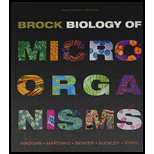
Brock Biology of Microorganisms, MasteringMicrobiology with eText and Access Card (14th Edition)
14th Edition
ISBN: 9780133857276
Author: Michael Madigan
Publisher: PEARSON
expand_more
expand_more
format_list_bulleted
Concept explainers
Question
Chapter 17.16, Problem 3MQ
Summary Introduction
The organisms that obtain energy from sunlight are known as photoautotrophs. These organisms are photosynthetic. They trap energy from sun rays and convert it into chemical energy to be utilized in the
Expert Solution & Answer
Want to see the full answer?
Check out a sample textbook solution
Students have asked these similar questions
Which chlorophyll pigment is found in golden and brown algae?
Besides chlorophyll, what additional light-harvesting pigments are found in the cyanobacteria?
What are thylakoids? What function do they have in photosynthesis?
Chapter 17 Solutions
Brock Biology of Microorganisms, MasteringMicrobiology with eText and Access Card (14th Edition)
Ch. 17.1 - Prob. 1MQCh. 17.1 - Prob. 2MQCh. 17.1 - Prob. 3MQCh. 17.2 - Prob. 1MQCh. 17.2 - Prob. 2MQCh. 17.2 - Prob. 3MQCh. 17.3 - Prob. 1MQCh. 17.3 - Prob. 2MQCh. 17.4 - Contrast the two nutritional options for Euglena.Ch. 17.4 - Prob. 2MQ
Ch. 17.4 - Prob. 3MQCh. 17.5 - Prob. 1MQCh. 17.5 - Prob. 2MQCh. 17.5 - What are apicoplasts, which organisms have them,...Ch. 17.6 - Prob. 1MQCh. 17.6 - Prob. 2MQCh. 17.6 - Prob. 3MQCh. 17.7 - Prob. 1MQCh. 17.7 - How are chlorarachniophytes thought to have...Ch. 17.8 - Prob. 1MQCh. 17.8 - Compare and contrast the lifestyles of gymnamoebas...Ch. 17.8 - Prob. 3MQCh. 17.9 - What are conidia? How does a conidium differ from...Ch. 17.9 - Prob. 2MQCh. 17.9 - Prob. 3MQCh. 17.10 - Why is the mold Penicillium economically...Ch. 17.10 - Prob. 2MQCh. 17.10 - Prob. 3MQCh. 17.11 - Prob. 1MQCh. 17.11 - Prob. 2MQCh. 17.11 - Prob. 3MQCh. 17.12 - Prob. 1MQCh. 17.12 - Prob. 2MQCh. 17.12 - Prob. 3MQCh. 17.13 - Prob. 1MQCh. 17.13 - Prob. 2MQCh. 17.14 - Prob. 1MQCh. 17.14 - Prob. 2MQCh. 17.15 - What traits link cyanobacteria and red algae?Ch. 17.15 - Prob. 2MQCh. 17.16 - What phototrophic properties link green algae and...Ch. 17.16 - What is unusual about the green algae...Ch. 17.16 - Prob. 3MQCh. 17 - Prob. 1RQCh. 17 - Prob. 2RQCh. 17 - Prob. 3RQCh. 17 - Prob. 4RQCh. 17 - Prob. 5RQCh. 17 - Three groups make up the alveolates: ciliates,...Ch. 17 - Prob. 7RQCh. 17 - REVIEW QUESTIONS
8. What morphological trait...Ch. 17 - Prob. 9RQCh. 17 - Prob. 10RQCh. 17 - Prob. 11RQCh. 17 - Prob. 12RQCh. 17 - Prob. 13RQCh. 17 - Prob. 14RQCh. 17 - Prob. 15RQCh. 17 - Prob. 16RQCh. 17 - Green algae are common in aquatic environments and...Ch. 17 - Explain why the process of endosymbiosis can be...Ch. 17 - Summarize the evidence for endosymbiosis. How...
Knowledge Booster
Learn more about
Need a deep-dive on the concept behind this application? Look no further. Learn more about this topic, biology and related others by exploring similar questions and additional content below.Similar questions
- Why did land plants lose some of the accessory pigments present in brown and red algae?arrow_forwardWhat are the major characteristics that distinguish cyanobacteria from other photosynthetic organisms?arrow_forwardWhat organisms were also called blue-green algae and why are they not algae?arrow_forward
arrow_back_ios
SEE MORE QUESTIONS
arrow_forward_ios
Recommended textbooks for you
 Biology (MindTap Course List)BiologyISBN:9781337392938Author:Eldra Solomon, Charles Martin, Diana W. Martin, Linda R. BergPublisher:Cengage Learning
Biology (MindTap Course List)BiologyISBN:9781337392938Author:Eldra Solomon, Charles Martin, Diana W. Martin, Linda R. BergPublisher:Cengage Learning

Biology (MindTap Course List)
Biology
ISBN:9781337392938
Author:Eldra Solomon, Charles Martin, Diana W. Martin, Linda R. Berg
Publisher:Cengage Learning
Microbial Nutrition and Growth; Author: Scientist Cindy;https://www.youtube.com/watch?v=rK3UkyWjkl8;License: Standard YouTube License, CC-BY